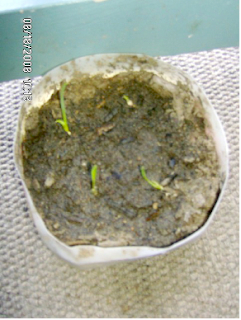22 December 2008
Furniture Polish
13 December 2008
Practicing Frugality
07 December 2008
Cheap Yogurt !
02 December 2008
New Discount Grocery in Town!
23 November 2008
Deodorant
What is a luxury?
06 November 2008
Because I Can't Say it Anywhere Else . . .
05 October 2008
No 'Poo
Clean Green
17 September 2008
Fat Soluble
16 September 2008
Worth While
13 September 2008
The Boy With a Drum
12 September 2008
More Kitchen Short-cuts
11 September 2008
The Complete Book of Self-Sufficiency
09 September 2008
Drink Special
02 September 2008
Bean Sprouts
01 September 2008
Fish Farming
30 August 2008
Garlic, Lentils, and Beans, oh my




First up, my planters: I’ve had the worst sort of success with the plants I bought at Wal Mart and stuck in pretty planters on our balcony. I’m not sure what went wrong. I had tomatoes, cucumbers, and zucchini, all of which are practically fool proof. When I watered them, the leaves turned yellow. When I didn’t water them for a day, thinking they were getting too much water, they went limp. So I’ve presently got two scrawny tomatoes that haven’t accomplished anything, and dead vines. Nice, right?
Then, a number of weeks ago, I saw a blog post by someone who took ordinary bought from the store brown lentils and got them growing at home. I naturally thought, “I can do that!” It doesn’t hurt that our weather has suddenly turned very spring like, with reasonably warm days in the mid 80’s and cool nights. So I got an empty gallon milk jug, cut it in half, filled with dirt, and planted a handful of seeds. Three weeks later, most of the seeds have sprouted and are growing joyously. I’ve thinned them once and expect to have to do so again in a couple weeks when the late starters really get going.
About a week after the lentils, my jar of farmer’s market garlic cloves got inexplicably damp. By the time I noticed and dried the jar out, quite a number of cloves had sprouted pretty green shoots. Considering my lentils had just started sprouting, I decided to get out another milk jug and some more dirt and plant garlic. In addition to sprightly sprigs of lentils, I also have four gregarious garlic shoots. They haven’t grown much in height yet but the frail little shoots popping out two weeks ago have turned into sturdy dark green leaves. I can see more leaves developing underneath too.
Yesterday I started thinking about how much Ba’al and I enjoy lima beans. It just so happens I have a jar of lima beans in my cupboard. “If I can get store bought lentils to grow, I wonder if I can get store bought beans to do the same?” I thought. Out came another milk jug (I save them for use as storage containers), the last of my potting dirt, and the jar of lima beans. In about two weeks, we will know the success or failure of this latest experiment.
I’ve already devoted a considerable amount of thought to the issue of pollination, which may very well need to happen after the birds, bees, and butterflies have disappeared until spring. If these lentils and beans happen to be self-pollinating varieties, then I have nothing to worry about. They will take care of themselves regardless of where they are growing, indoors or out. If they need some external mechanism, I may find myself pollinating with a Q-tip or situating them in front of a briskly blowing fan. Needless to say, I am very much hoping either for self-pollination or for flowers to occur before fall truly sets in!
I am at least guaranteed successful garlic at this point. I have a tendency to forget garlic when I go shopping so having the capability of growing garlic inside practically the year around makes me quite happy. Even if I don’t get any produce from the other experiments on this go around, it makes me quite happy to see pretty green growing things inside or out on the porch.
Housing Codes and Local Laws
29 August 2008
Recycling
Now I know why
13 August 2008
:=D :=D :=D :=D
05 August 2008
Agricultural Adjustment Act of 1935
04 August 2008
Use it up. . . . or do without
02 August 2008
Use it up, wear it out, make it work or do without
16 July 2008
Recycling glass
14 July 2008
Crop Management
05 July 2008
Grey Water and Rain
03 July 2008
Dairy Girl, Part Deux
02 July 2008
Dairy Girl
30 June 2008
The Hair's the Thing
29 June 2008
Heat
28 June 2008
We're Going Tankless
26 June 2008
Oops
24 June 2008
Converted
23 June 2008
Teff
22 June 2008
Quinoa
Hummus
21 June 2008
Forgot to Mention
Adventures in Sourdough
18 June 2008
Prototype
17 June 2008
Woot!
16 June 2008
One Down, Many To Go
15 June 2008
The Things I Can Do
- Ruthlessly turn off all lights when not in use.
- Unplug appliances when not in use.
- Limit use of the A/C by utilizing fans and open windows as much as possible.
- Figure out a cloth diaper system practical for our small apartment and shared washing machines.
- Make fabric wipes for Yeled's butt.
- Line dry clothes instead of paying for dryer time.
- Recycle everything that can be recycled.
- Get and use a self-contained compost bucket.
- Buy used clothes, furniture, and household items. As a sign in a local antique shop reads, "buy green, buy antique."
- Instead of buying pre-made kitchen things (like pancake mix, pasta, and so on) make these things at home. Why buy them if I can make them myself?
